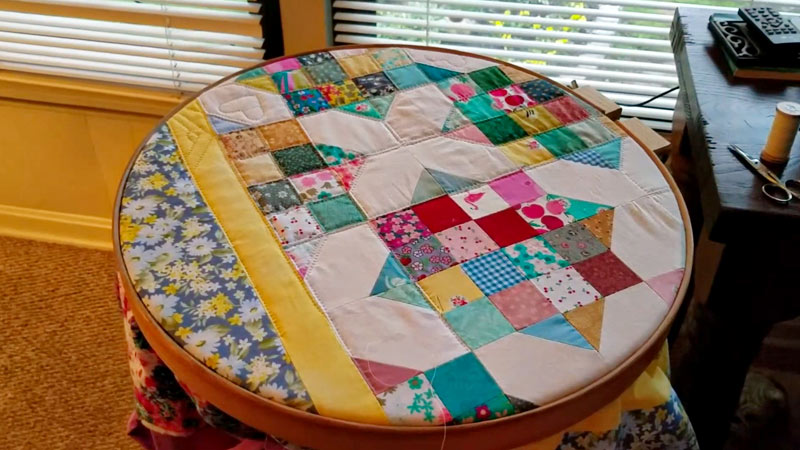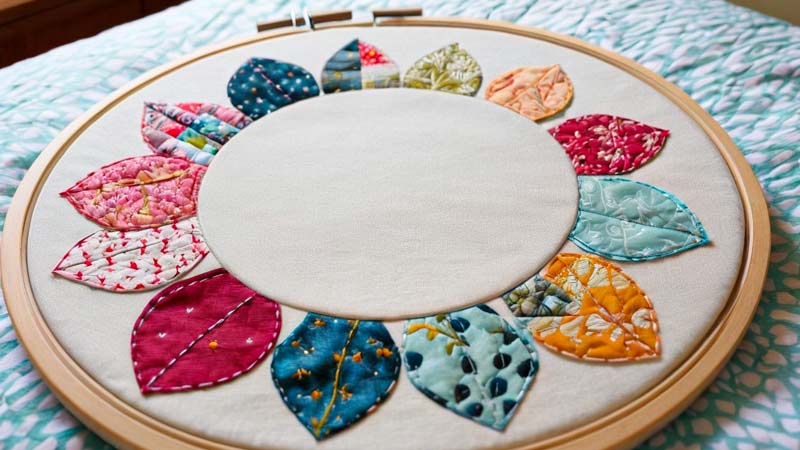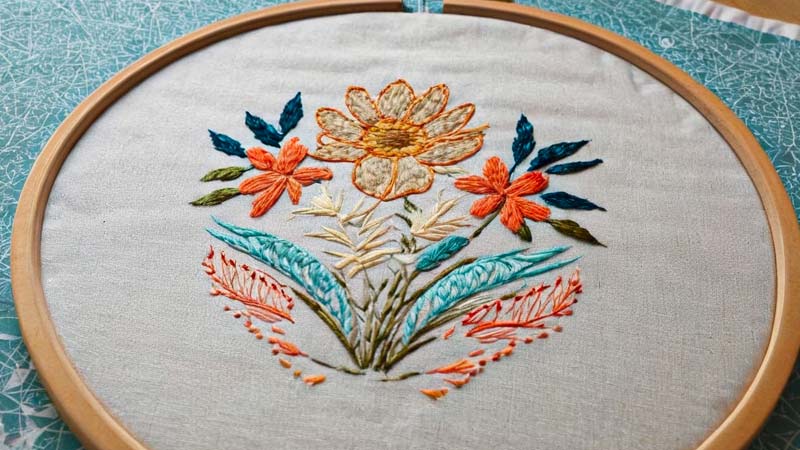Embarking on the quilting world unveils a realm of creativity and skillful stitching. A common question arises: Do you need an embroidery hoop to quilt? While not definitive, the answer hinges on individual preferences and project nuances.
An embroidery hoop, a circular or oval frame, offers advantages like even tension and enhanced control. However, many quilters opt to forgo the hoop, finding it cumbersome for larger projects or preferring the freedom of working without constraints.
This exploration delves into the pros and cons, aiding both novice and seasoned quilters in deciding whether an embroidery hoop is an indispensable tool for their unique quilting journey.

Do You Need an Embroidery Hoop to Quilt?
No, an embroidery hoop is not essential for quilting. While it can provide benefits such as even tension and better control, many quilters choose to quilt without a hoop.
Quilting can be done by hand or machine, and choosing a hoop depends on personal preference and project requirements. Some find hoops helpful for intricate designs, while others find them cumbersome, especially for large quilts.
Whether to use an embroidery hoop is subjective; experimentation with and without a hoop can help determine what works best for individual quilting styles.
Pros of Using an Embroidery Hoop for Quilting
Using an embroidery hoop for quilting comes with several potential advantages, depending on the quilter’s preferences and the project’s specific requirements.
Here are some pros of using an embroidery hoop for quilting:
Even Tension
An embroidery hoop helps to maintain even tension in the fabric, preventing it from bunching or puckering during the quilting process. This can contribute to a neater and more professional-looking finished product.
Controlled Stitches

The hoop provides a stable surface for quilting, allowing for more control over the stitching process. Quilters, especially those working on intricate designs, may find it easier to achieve precise and consistent stitches when using a hoop.
Support for Small Designs
Hoops are particularly beneficial when working on smaller or more detailed quilt sections, such as appliqué or embroidery. They provide a focused area for attention, making it easier to navigate through intricate patterns.
Reduced Hand Fatigue
Holding a hoop can provide additional support, reducing hand and wrist fatigue during extended quilting sessions. This can be especially helpful for those who engage in hand quilting, where consistent stitching may take considerable time.
Prevention of Fabric Creases
When used correctly, an embroidery hoop can help prevent fabric creases, ensuring the quilt remains smooth and flat during the quilting process. This is particularly important when working with delicate or easily creased fabrics.
Stain Protection
The hoop can act as a barrier between the quilter’s hands and the fabric, helping to protect the material from dirt, oils, or stains that might transfer from the skin or work surface.
Cons of Using an Embroidery Hoop for Quilting

While using an embroidery hoop for quilting has its advantages, there are also potential drawbacks and challenges associated with this tool.
Here are some cons of using an embroidery hoop for quilting:
Inconvenience for Large Quilts
An embroidery hoop can be cumbersome and inconvenient, especially when working on large quilts. Hoops are typically limited in size, and repositioning them frequently to cover different areas of a large quilt can slow down the quilting process.
Fabric Distortion
If the hoop is too tight or left on the fabric for an extended period, it may cause distortion or stretching of the fabric. This can affect the overall appearance and drape of the quilt.
Creases in the Fabric
Improper use of the hoop, such as leaving it on for too long or using excessive tension, can lead to creases or wrinkles in the fabric. Removing the hoop when not actively quilting and careful tension adjustment is essential to avoid this issue.
Limited Maneuverability
Hoops restrict the size of the working area, limiting the quilter’s ability to move and manipulate the fabric freely. This constraint may be challenging when quilting larger sections or using a sewing machine for quilting.
Risk of Fabric Damage
If not used carefully, the hoop’s hardware (screws, springs, etc.) may snag or damage the fabric, leading to holes or tears. It’s essential to choose a smooth mechanism hoop and handle it carefully.
Added Weight
The hoop adds some weight to the quilt, which can make it more challenging to handle, particularly for quilters who prefer to move the quilt around as they work.
Not Suitable for All Techniques
While an embroidery hoop may benefit specific quilting techniques, it might not suit others. For instance, some quilters prefer not to use a hoop when free-motion quilting.
Interrupted View of Entire Quilt
The hoop covers a portion of the quilt, which may make it challenging to maintain a consistent overall appearance. Quilters who prefer to see the entire quilt as they work may find this limiting.
What Factors Should You Consider When Choosing an Embroidery Hoop?

Choosing the right embroidery hoop ensures a comfortable and practical quilting or embroidery experience. Here are some factors to consider when selecting an embroidery hoop:
Size
Choose a hoop that is appropriately sized for your project. The hoop should be large enough to accommodate the area you are working on comfortably but not so large that it becomes unwieldy.
Shape
Embroidery hoops come in various shapes: round, oval, and square. The shape you choose depends on your personal preference and the shape of your quilting or embroidery project.
Material
Hoops are commonly made from wood or plastic. Wood is durable and provides a classic feel, while plastic is lightweight and may have features like non-slip grips. Choose a material that suits your preferences and the demands of your project.
Closure Mechanism
Consider the type of closure mechanism the hoop uses. Hoops typically have a screw or spring mechanism to hold the fabric taut. Choose a hoop with a secure and easy-to-adjust closure mechanism.
Quality
Invest in a high-quality hoop to ensure durability. Look for smooth edges, sturdy construction, and materials that won’t warp.
Weight
Consider the hoop’s weight, especially if you’ll be working on larger projects. A lightweight hoop may be more comfortable for extended periods of use.
Grip or Non-slip Features
Some hoops have added features such as non-slip grips or coatings to prevent the fabric from slipping. This can be particularly useful when working on intricate designs.
Ease of Use
Choose a hoop that is easy to assemble and disassemble. This is important for quick adjustments and when you need to switch to a different area of your project.
Compatibility with Fabric
Ensure that the hoop is suitable for the type of fabric you’re using. Delicate fabrics may require a gentler hoop, while thicker fabrics may need a sturdier one.
Brand Reputation
Consider the reputation of the brand. Well-established brands often produce reliable and high-quality embroidery hoops.
Price
While cost shouldn’t be the only factor, consider your budget. Good-quality hoops are available at various prices, so find one that meets your needs without breaking the bank.
FAQs
Can quilting be done without an embroidery hoop?
Yes, quilting can be done without an embroidery hoop. Many quilters choose to work without a hoop for flexibility and ease.
Are there risks of fabric damage when using an embroidery hoop?
We are addressing concerns about potential fabric damage and providing tips on careful handling and choosing a suitable hoop.
Can I use an embroidery hoop for machine quilting?
While embroidery hoops are commonly associated with hand quilting, they are not typically used for machine quilting. Machine quilting is often done with the fabric secured in a quilting frame or using a free-motion quilting technique.
Are there alternatives to embroidery hoops for hand quilting?
Yes, alternatives include quilting frames and hoopless techniques. Quilters often use basting, tacking, or other methods to secure the fabric layers without needing a traditional embroidery hoop.
Can I use an embroidery hoop for quilting if I’m a beginner?
Yes, beginners can use an embroidery hoop to enhance control and stitch consistency. However, it’s essential to experiment and determine personal preferences, as some beginners may find quilting without a hoop more intuitive.
To Recap
The choice of using an embroidery hoop for quilting is subjective, influenced by personal preferences and the nature of the project.
While the hoop offers advantages like even tension and controlled stitching, it may not be essential for every quilter.
Some find joy in the flexibility of quilting without constraints, especially with larger projects. Ultimately, embracing the circular frame or quilt freely is an individual decision.
As you navigate the world of quilting, experimenting with both approaches will illuminate the path to a technique that aligns seamlessly with your unique style, ensuring a satisfying and enjoyable quilting experience.
Leave a Reply